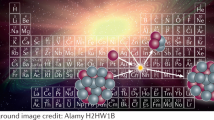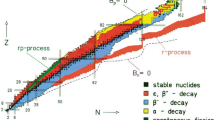Conclusions
From our analysis of the experimental studies of element 103, conducted at Dubna and Berkeley, we can draw the following conclusions.
-
1.
At the present time, the best studied has been the isotope of element 103 with mass number 256, synthesized in Dubna. In 1965 a value of the half-life of 45±10 sec was obtained for it by observation of the daughter products of decay. In the 1967 studies it was established for this isotope by direct observation of its α-decay that it emits α-particles with 8.35<Eα<8.50 MeV with the most intense group at 8.42 MeV and has a half-life of ∼35 sec. According to estimates, the ratio of the probability of α-decay to the probability of electron capture is ∼>1.
-
2.
The data obtained in Berkeley in 1961 on the properties of the isotope 103257 (Eα=8.6 MeV, T1/2=8±2 sec) were not confirmed by experiments conducted at Dubna. The data obtained in Dubna in 1967 on the properties of the isotope 103257 (T1/2∼35 sec and 8.5<Eα<8.6 MeV) will require further refinement.
-
3.
The activity with Eα=8.6 MeV and T1/2=8±2 sec, obtained in work on element 103 conducted in Berkeley in 1961 and orginally assigned to the isotope 103257, is now ascribed by the authors to the isotope 103258 or 103259. It is not known what lies at basis of the new analysis, the conclusions of which contradict part of the experimental results of the original work; however, it seems to us that additional experimental data will be needed to substantiate the new conclusion.
Similar content being viewed by others
Literature Cited
E. D. Donets, V. A. Shchegolev, and V. A. Ermakov, Atomn. Énerg.,19, 109 (1965).
G. Flerov et al., Nucl. Phys.,A106, 476 (1967).
G. N. Flerov et al., Preprint of the Joint Institute of Nuclear Research R7-3556 [in Russian], Dubna (1967).
A. Ghiorso et al., Phys. Rev. Letters,1, 18 (1958).
A. Ghiorso, Proc. of the Second Conf. on Reactions between Complex Nuclei, Gatlinburg, May 2–4 (1960), p. 195.
A. Ghiorso et al., Phys. Rev. Letters,6, 473 (1961).
E. D. Donets, V. A. Shchegolev, and V. A. Ermakov, Atomn. Énerg.,16, 195 (1964).
R. Macfarlane and R. Griffioen, Nucl. Instrum. and Methods,24, 461 (1963).
V. L. Mikheev, Pribory i Tekhnika Éksperimenta, No. 4, 22 (1966).
B. A. Zager et al., Atomn. Énerg.,20, 230 (1966).
V. L. Mikheev et al., Atomn. Énerg.,22, 90 (1967).
V. A. Druin et al., Atomn. Énerg.,22, 127 (1967).
G. N. Flerov et al., Yadernaya Fizika,5, 1186 (1967).
G. N. Flerov et al., Yadernaya Fizika,7, 239 (1968).
G. N. Akap'ev et al., Preprint of the Joint Institute of Nuclear Research E7-3261 [in Russian], Dubna (1967).
A. Ghiorso et al., Phys. Rev. Letters,18, 401 (1967).
A. Ghiorso, Private Communication, reported by C. M. Lederer, J. M. Hollander, and I. Perlman, Table of Isotopes, 6th ed., John Wiley and Sons (1967).
G. Seaborg, Actinides Reviews,1, 3 (1967).
V. Viola and G. Seaborg, J. Inorg. and Nucl. Chem.,28, 697 (1966).
Additional information
Translated from Atomnaya Énergiya, Vol. 25, No. 2, pp. 87–94, August, 1968.
Rights and permissions
About this article
Cite this article
Donets, E.D., Durin, V.A. & Mikheev, V.L. Element 103 of the periodic system. At Energy 25, 837–844 (1968). https://doi.org/10.1007/BF01121035
Received:
Issue Date:
DOI: https://doi.org/10.1007/BF01121035




